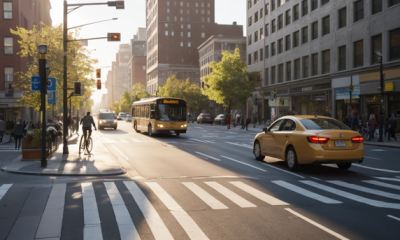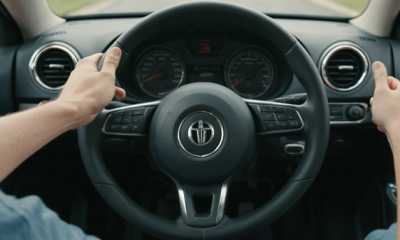Driving Tips
How to Parallel Park on a Hill – Master It with Ease Today

How to parallel park on a hill without stress? Learn the right steps, safety tips, and tricks to confidently park uphill or downhill every time.
How to Parallel Park on a Hill Like a Pro 🚗
Ever felt nervous parking on a hill, worried your car might roll away? 😬
You’re not alone. It’s one of those driving skills most people try to avoid—but it’s super important.
So how do you parallel park on a hill safely and correctly?
It’s all about technique, wheel direction, and a little confidence. Once you learn the steps, you’ll feel totally in control, even on the steepest slopes.
Let’s dive into this hill-parking survival guide—with practical tips, step-by-step instructions, and real talk to help you master it for good.
Understand Why Hill Parking Matters ⚠️
When your car is parked on an incline, gravity becomes your enemy.
If it’s not secured properly, it can roll, damage property, or even cause injuries.
That’s why every state’s driving manual (including DMV rules) includes hill parking techniques in the license test.
Why it matters:
- Prevents accidents and rollaways
- Keeps your car and others safe
- Shows you’re a skilled and responsible driver
🚗 Mastering this skill isn’t just smart—it’s required.
What Is Parallel Parking on a Hill? 🅿️
It’s the act of parking between two vehicles alongside a curb on a slope—either facing uphill or downhill.
It involves:
- Positioning your car correctly
- Turning your wheels in the right direction
- Using the emergency brake (a.k.a. parking brake)
- Knowing the incline and adjusting according
📍 The angle of the hill makes a big difference in how you park.
Know the Basics of Wheel Positioning 🛞
This is the most important part of hill parking.
Get the wheel direction wrong, and your car could roll into traffic.
Here’s a quick summary:
| Situation | Wheel Direction |
|---|---|
| Uphill with curb | Turn wheels away from the curb |
| Uphill without curb | Turn wheels toward the shoulder |
| Downhill (any case) | Turn wheels toward the curb |
👉 Remember this rule: wheels should roll into something—not into the street.
Step-by-Step: How to Parallel Park Uphill with a Curb ⬆️🧱
Here’s how to do it right:
- Signal and pull up next to the vehicle in front of your spot
- Check mirrors and blind spots
- Reverse slowly, turning the wheel right to angle your car in
- Straighten out and center between the cars
- Turn wheels left (away from curb)
- Let the vehicle roll gently backward until the back tire touches the curb
- Engage the parking brake
- Put the car in “Park” (auto) or first gear (manual)
🧠 This forms a “curb block” that stops your car from rolling into the street.
Step-by-Step: How to Parallel Park Uphill Without a Curb ⬆️🌾
If there’s no curb, here’s what to do differently:
- Follow steps 1–4 above
- Turn wheels right (toward the edge)
- Let the car roll slightly forward
- Engage the parking brake
- Put it in “Park” or first gear
🛑 The goal is to make your car roll safely into grass or dirt—not down the hill.
Step-by-Step: How to Parallel Park Downhill ⬇️
Parking downhill is more common—and easier—than uphill.
Here’s how to do it:
- Signal and stop parallel to the car ahead
- Check surroundings and back in slowly
- Once in position, turn wheels right (toward curb)
- Let the car roll until front tire touches the curb
- Engage the parking brake
- Put it in “Park” or reverse (manual cars)
🧠 This way, gravity helps the car stop instead of making it move.
🔧 Gear Shift Positions by Car Type
| Car Type | Recommended Gear for Hill Parking |
|---|---|
| Automatic Transmission | “P” for Park + parking brake |
| Manual Transmission | 1st gear (uphill), reverse (downhill) |
📌 Always set the parking brake first, then gear. Reverse the order when starting the car.
Use the Parking Brake—Always! 🛑
Many drivers skip the parking brake out of habit. Don’t.
It’s a vital backup if your transmission fails or the car is bumped.
On a hill, it’s your best friend.
Here’s why it matters:
- Keeps your car from rolling
- Reduces stress on your transmission
- Adds an extra layer of safety
🧠 Make it a habit to set it every time, even on slight inclines.
Know the Slope of the Road 📉
Not all hills are obvious. A slight incline can affect your car.
How to tell?
- Look at parked cars nearby
- Watch how water flows when it rains
- Use your car’s level indicator (if equipped)
- Trust your instincts—if it feels like it’s rolling, it is!
🌟 Even subtle slopes require proper wheel positioning.
Practice Makes Perfect 🧠
Don’t wait until you’re on a steep street downtown. Practice in a safe, quiet neighborhood.
Practice in these places:
- Your own driveway (if it’s sloped)
- Empty side streets
- Low-traffic urban hills
Practice until you feel confident turning wheels and using your mirrors.
🚗 Muscle memory helps in high-stress situations.
Avoid These Common Mistakes ❌
Even experienced drivers make mistakes. Here are a few to avoid:
- Not turning wheels correctly
- Forgetting the parking brake
- Parking too far from the curb
- Leaving your car in neutral
- Ignoring slope direction
Fix these mistakes, and you’re 90% safer already.
How Far from the Curb Should You Park? 📏
You should park no more than 12 inches (1 foot) from the curb.
Why it matters:
- Keeps traffic flowing
- Prevents tickets
- Ensures proper wheel contact if needed
📌 Always finish with your tires snug—but not scraping—the curb.
💼 DMV Hill Parking Requirements by State
| State | Test Requirement |
|---|---|
| California | Mandatory on road test |
| Texas | Visual test and oral questions |
| New York | Required in parallel section |
| Florida | Often included in written test |
| Illinois | Included in both written & road |
💡 Most states will dock points or fail you if hill parking is done incorrectly.
Should You Use Wheel Chocks or Blocks? 🧱
If you park on very steep inclines often—or leave your car unattended for long periods—wheel chocks can add security.
These are rubber or plastic wedges placed behind your tires.
When to use them:
- Long-term parking
- Unpaved or gravel surfaces
- Steep mountain drives or construction sites
🧠 They’re inexpensive, portable, and great for peace of mind.
What to Do Before Pulling Out Again 🏁
Ready to leave your hill parking spot? Don’t just drive off.
- Start the engine
- Release the parking brake
- Check all mirrors and blind spots
- Turn the wheels straight before pulling out
- Signal and move out slowly
🧠 Always ease into traffic—remember, cars behind may not expect a hill start.
Final Thoughts 🚦
Hill parking might seem like a tiny detail—but it plays a big role in road safety.
Whether you’re facing a steep San Francisco street or a gentle neighborhood slope, knowing how to parallel park on a hill protects your car, your license, and your peace of mind.
To recap:
- Know your slope (uphill or downhill)
- Turn wheels in the right direction
- Always use your parking brake
- Practice until it becomes second nature
- Stay no more than 12 inches from the curb
So next time you’re facing that hill, take a breath—you’ve got this. 💪
❓ FAQs
How do I know which way to turn my wheels?
Use the curb to stop your car: uphill with curb = away, downhill = toward the curb.
What gear should I use when parked on a hill?
Use “Park” in automatics, 1st gear uphill or reverse downhill in manuals.
Is it illegal not to use the parking brake on hills?
Yes, in many states it’s legally required—and it’s always safer.
Can I park facing downhill with no curb?
Yes, but always turn wheels toward the side of the road or shoulder.
Why does my car roll even in Park on hills?
That means the parking brake isn’t engaged or the transmission is under strain.
🔗 References
https://www.dmv.ca.gov
https://exchange.aaa.com
https://driving-tests.org
-

 Driving Tips4 weeks ago
Driving Tips4 weeks agoSafe Driving Tips In Heavy Fog – Stay Smart, Drive Confident
-

 Auto Parts4 weeks ago
Auto Parts4 weeks agoHow to Identify a Car Part Number Fast – Expert Tips Inside
-

 Driving Tips3 weeks ago
Driving Tips3 weeks agoDefensive Driving Techniques for City Traffic – Proven Smart Tips
-

 Driving Tips2 weeks ago
Driving Tips2 weeks agoHow To Drive A Manual Transmission – Master The Skill Fast!






